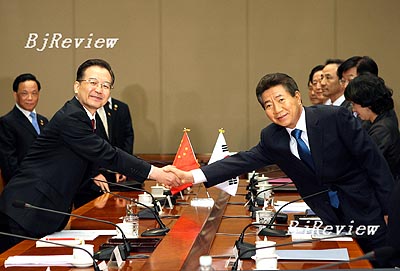
For decades after the founding of the People's Republic of China in 1949, China and the Republic of Korea were sworn enemies. Little wonder then that the thaw in bilateral relations that started in the early 1990s had profound repercussions in the entire region.
The establishment of diplomatic relations between China and South Korea and the further development of the two countries' relations helped destroy the region's Cold War structure that pitted China and North Korea against South Korea, the United States and Japan. It also stabilized the situation on the Korean Peninsula and paved the way for peace between Seoul and Pyongyang, said Li Dunqiu, Director of the Center for Korean Peninsular Studies at the Institute of World Development under the Development Research Center of China's State Council.
The moves "had far-reaching implications as they to some extent curbed the emergence of the new Cold War mentality in Northeast Asia and created conditions for future regional security and economic cooperation," Li said.
Relations between China and South Korea began to improve after China adopted the reform and opening-up policy in the late 1970s. In 1991, both nations opened trade offices in each other's countries. These pioneering efforts led to the formal establishment of diplomatic relations on August 24, 1992.
Fifteen years on, the two countries have seen their relations growing rapidly across the board. At a recent seminar in Beijing marking the anniversary of the establishment of diplomatic relations between the nations, scholars and diplomats painted a rosy picture of the future cooperation between China and South Korea, while reviewing their past achievements.
Political relations were upgraded with frequent exchanges of high-level visits, Li said. When former South Korean President Kim Dae Jung visited China in 1998, both countries announced plans to establish a "cooperative partnership for the 21st century." During South Korean President Roh Moo Hyun's visit to China in 2003, the two countries redefined their relations as a "comprehensive cooperative partnership."
Chinese President Hu Jintao visited South Korea in November 2005, further deepening and expanding bilateral relations. Chinese Premier Wen Jiabao visited South Korea this April, as part of the celebrations for the Year of Exchange for China and South Korea.
The two countries have maintained good consultation and cooperation in regional and international affairs, Li said. He noted that China and South Korea are making concerted efforts toward a peaceful solution to the North Korean nuclear issue. They share similar positions on many major issues in the six-party talks to resolve the nuclear crisis in North Korea and have contributed to creating a peaceful Korean Peninsula, he said.
In economic matters, China is South Korea's largest trading partner and its biggest foreign investment destination, whereas South Korea is China's third largest trading partner. The two countries' trade volume was only about $5 billion in 1992. In 2003, they set a goal of raising it to $100 billion by 2008, but they reached that goal three years in advance. Two-way trade hit $134.3 billion in 2006, nearly 27 times of 1992.
While there is widespread interest in South Korean soap operas, movies, pop music, video games and national costumes among the Chinese, the Chinese culture is gaining popularity in South Korea. More than 10 books on China are published in South Korea every day. TV stations that specialize in broadcasting Chinese programs such as Hao TV and China TV have mushroomed.
Some 130 South Korean colleges have Chinese departments, turning out roughly 3,000 graduates annually. In 2006, about 99,000 South Koreans took the Chinese Proficiency Test out of a total 162,000 test-takers around the world. China set up its first-ever Confucius Institute abroad in Seoul at the end of 2004. These non-profit, educational institutions promote the teaching of Chinese language and culture in foreign countries.
| 